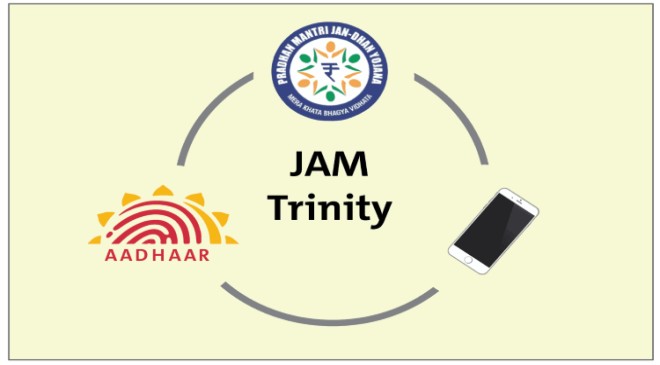Over the course of the last several decades, India’s efforts to expand its population’s access to formal financial services have been accompanied by a number of regulatory breakthroughs. That meant promoting bank nationalisation in the early 1970s and expanding access to banking in rural regions.
One approach was to employ the ‘Jan Dhan Account-Aadhaar-Mobile (JAM) trinity to help the needy get their welfare payments via Direct Benefit Transfers (DBTs) into their bank accounts. The primary goal was to boost account ownership and use by facilitating direct government deposits for people. The consequence would be an expansion of the official financial system’s reach into the areas of the market it has hitherto ignored.
What is JAM trinity
Jan Dhan Yojana’s universal access to basic bank accounts, the Aadhaar biometric identifier, and India’s fast expanding mobile phone network constitute the backbone of the JAM architecture.
The Aadhaar number serves as a biometric identification verification and is used to determine whether citizens are qualified to participate in different government programmes. The linking of Aadhaar numbers to bank accounts means that they may also serve as a person’s financial address, streamlining the process of making electronic welfare payments.
To participate in the Mahatma Gandhi National Rural Employment Guarantee Scheme (MGNREGS) or the Indira Gandhi National Old Age Pension Scheme (IGNOAPS), for instance, a person must provide their Aadhaar number and other identifying information (IGNOAPS). Their Aadhaar number would be used to verify their identification, and any benefits due to them would be deposited into the bank account associated with that number.
When citizens receive a government transfer, it is deposited into their Jan Dhan Accounts, which are simple checking accounts with no frills. Additionally, the widespread availability of mobile phones makes it possible to reach out to them and inform them of the successful transfer of their welfare payment.
Read More: Bank holidays 2023: Banks to remain closed on these days; check month-wise list
Benefits of JAM trinity system
Increasing the number of people who have bank accounts was a major goal of the JAM programme, which aimed to do this through expanding financial services to those at the base of the economic pyramid.
Jan Dhan accounts were first made available in conjunction with the RuPay debit card and state-run pension and insurance programmes. The bottom of the pyramid benefited from this consolidation since they could have easier access to several forms of credit and other financial services.
The traditional method of transferring money included using physical channels, which introduced inefficiencies due to the presence of intermediaries. Distribution of cash in person was inefficient for both the government and the recipients. The DBT method dispensed with the need for intermediary banks by allowing direct electronic transfers of funds into bank accounts. Beneficiaries’ identities can be verified by their Aadhaar numbers being seeded into their bank accounts, ensuring that the right people were receiving their welfare payments.



































